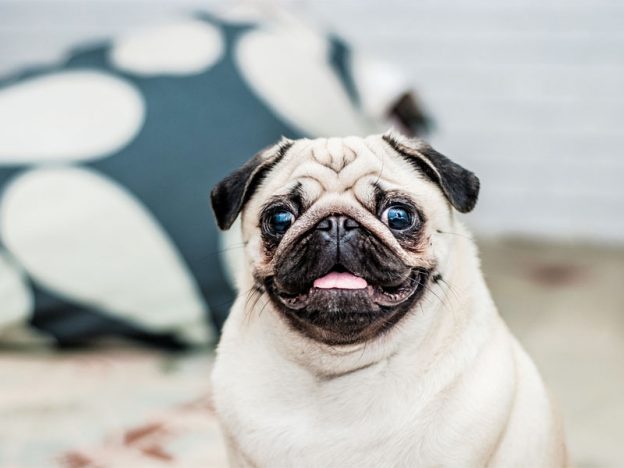
Whether they are just plain unsightly or a warning sign that all is not well with your pooch, tear stains are a common sight in dogs. Mel Hearse gets down to the nitty-gritty of these little markings
Ever wondered what those little rust-coloured marks that develop around your dog’s eyes are or perhaps what causes them? Called tear stains, they’re essentially the result of excess tear production, Dr Rachel Chay, chief veterinarian at Petbarn and Greencross Vets, says. The staining itself is caused by dye molecules called porphyrins, which all dogs produce. These porphyrins are iron-containing molecules, produced when the body breaks down red blood cells, and are excreted primarily through bile and the intestinal tract. Excessive amounts of porphyrin are excreted through tears, saliva and urine. If this sits on white or light fur for any length of time, the fur will stain, intensifying or darkening in the presence of sunlight.
Tear staining is more of a problem in breeds with more prominent or “bulgy” eyes, because they quite often produce more tears to keep the surface of their eye moist, Dr Rachel explains. “Breeds such as Pugs, French Bulldogs and Maltese Terriers are more prone to this condition and it is more noticeable in light-coated dogs.”
If your pet does suffer frequent tear staining, Dr Rachel says it is important that you seek advice from your veterinarian, as there’s a veritable laundry list of potential causes of excessive tearing — some more serious than others. It can be an indicator of eye infections, glaucoma or blockage of tear ducts, or may be caused by ingrown eyelashes, unusually large tear glands, medications, exposure to second-hand smoke, a poor-quality diet — even plastic bowls have been blamed.
Excessive tear production can also occur if the tear ducts are blocked due to scar tissue from previous eye infections or abnormal development. Long hairs from the face, or hairs growing in parts of the eyelid that they shouldn’t, will also rub on the eyeball, causing irritation, excessive tear production, discharge and long-term damage to the eyeball. And neither last nor least, seasonal allergies can also be at play and the reason for your pet’s excessive “crying”.
Danger, danger: Could it be more serious?
One of the more serious eye conditions that may be underlying your pet’s frequent tearing and subsequent staining is entropion, an abnormality of the eyelids in which the eyelid rolls inward, often causing the hair on the surface of the eyelid to rub against the cornea. This can result in corneal ulcers, corneal erosions, or irreversible corneal scarring that can interfere with your dog’s vision. The good news is the surgery used to treat the condition has a very high success rate, so getting onto it quickly can mean no further issues for Fido.
A common cause of tear staining is the tear duct being too narrow to drain away the tear fluid, causing tears to spill over onto the cheek. Narrow or absent tear ducts are often a congenital condition associated with many small breeds such as the Miniature Poodle. This will need to be inspected by a vet and can sometimes be corrected surgically, though this does carry significant risks and should be discussed with a vet who knows your dog, his condition and the potential outcome.
Tear staining can also be a symptom of glaucoma, a serious condition if not treated promptly. Common in humans, it’s also surprisingly frequent in dogs and occurs when the pressure inside the globe (eyeball) becomes higher than normal. Excessive pressure inside the eye can damage the eye’s internal structure and, unless glaucoma is treated quickly, permanent loss of vision or even total blindness can result.
Many different conditions can cause glaucoma and it’s classified as either primary or secondary in animals. Primary glaucoma is an inherited condition which occurs in many breeds of dogs, including the American Cocker Spaniel, Basset Hound, Chow Chow, Shar Pei, Jack Russell Terrier and Shih Tzu. Secondary glaucoma occurs when other eye diseases cause decreased drainage of fluid from the inside of the eye. Common causes of secondary glaucoma include inflammation inside the eye (uveitis), advanced cataracts, cancer in the eye and lens subluxation or luxation.
Cleaning and preventing tear stains
If you’ve ruled out more serious causes, or the excessive tearing is breed related and can’t be corrected, then step one in prevention or management is to assess any lifestyle changes. If, for example, you’ve changed to a plastic food bowl or changed your dog’s diet, switching back may solve the issue. Moved to a house where grass may be getting into your dog’s eyes and aggravating them? You may find more frequent cleaning (with water) or keeping your pet indoors as much as possible will help. For some dogs, however, Dr Rachel says tear stains cannot be totally avoided but simply managed.
Tear stains in most dogs can be managed by trimming the facial hair and wiping your dog’s face at least twice a day with a slightly damp washcloth. Dr Rachel says that once medical conditions have been ruled out and treated if required, it is simply a matter of keeping the area clean.
“Given it is the delicate eye area, owners should not be using soaps or lotions to clean or bleach the area. Simply cleaning the area with a soft cloth and warm water will help,” she says.




